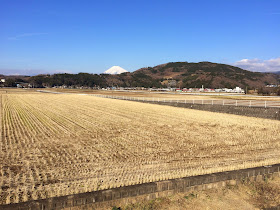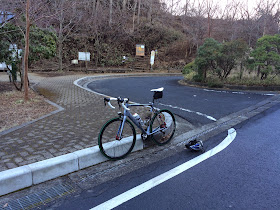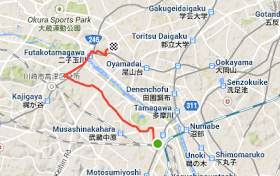As regular readers know, I am a
big fan of the SV-8 dynamo, having ridden my SV-8 on lots of 600km, 1000km, 1200km, many shorter and one even longer (1420km+ -- LEL) randonneuring events in recent years, putting in 15~20,000 kms, conservatively, with this light source. And I use an SD-8 (disk version) on my commuting rig, and a PV-8 (greater output) as well, and have built up a number of SV-8's and PV-8's for friends.
The new model is out! SP Dynamo has sent me a couple of SV-9 hubs. Announced last summer, the wait is over.
I measure a weight of approx. 313 grams, down from approx 371 grams for the SV-8. So 16% lighter. Much smaller also. As long as it works as well as the SV-8/PV-8 ... a major improvement just based upon smaller size and weight.
 |
| Left: SV-8, Right: SV-9. Big reduction in size, and weight. |
 |
| SV-9 fits in the palm easily. |
 |
| My SV-9 weights 313 grams. Just a wee bit more than the advertised 309 grams. |
 |
| An SV-8 weighs in at 371 grams. |
I built up the hub with an H Plus Son Archetype rim -- wide, deep, attractive (black with white graphics) and sturdy enough for long distance audax/randonneuring, and Sapim CX Ray spokes -- the best spokes I have used ( ... if more expensive than non-bladed options). The result is a beautiful wheel that should be very durable and fast. Wheel No. 00025.
Of course, the hub's low weight (for a dynamo) means that even with a sturdy rim and 32/3-cross spokes, the wheel is the lightest dynamo-hubbed front wheel I have yet to see, weighing in at 955 grams.
 |
| 955 grams for the wheel, including sturdy rim and 32 3-cross spokes. |
How does it work on the road? Well, stay tuned for updates.
The electric output is not materially different than the SV-8. As with the SV-8, output is not QUITE enough at low speeds to be certified in Germany for use with standard 700mm road wheels, but plenty of power in practice for someone who rides at normal speeds and who uses modern LED lights.
What is the main difference, other than the lighter weight? My first impression is that the hub's resistance/drag is impressively tiny when no light is attached (or on). My spin test suggests it is signficantly lower resistance than the 8 series (which was best in its class). No, my front wheel built with the SV-9 does not spin for 4+ minutes, like my Gokiso front hub/wheel. But it does spin for 40+ seconds. That is a lifetime compared with other dynamos and suggests truly negligible drag. First rides in the neighborhood confirm this. On December 28 the hub will get its first real test.
UPDATE (Dec 28, 2014): I took the first extended ride with the SV-9/H Plus Son wheel, 185 kms from Tokyo to Shizuoka, over Atami Pass, then another 15 kms back home from the Shinkansen station at Shin Yokohama. The hub works just fine. No noticeable difference from the SV-8, except it rolls even smoother with the light switched off (am I imagining it)? And, of course, a front wheel that is around 60 grams lighter -- not noticeable to me except perhaps in my imagination, spinning up to climb on steeper sections of the climb to Atami Pass.
I left home at 4:25AM, so used the light for the first 3 hours or so (to Odawara), as well as for 45 minutes of the at-dusk ride home from Shin Yokomama. I turned the light off during day, but switched it on for the 600 meter elev. descent from Atami Pass -- so cars, if any, would see me coming sooner in the mirrors on the curvy road, and for some stretches on crowded roads where I wanted cars to be more aware of me as I passed by along the curbside at stop lights or in slow traffic. If it holds up as well as the SV-8 over time, it will be THE hub for randonneurs who want the convenience of dynamo lighting with a "normal" road bike feel and who want to complete events with fast times.
I remember reading a ride report recently from an American cyclist who rode in the "front group" at a recent PBP and commented there were few or no dynamo hubs among these folks -- pure road racing set ups. With a product such as the SV-9, I would be curious if 2015 is different ... though I will only have a fleeting instant to check, as those folks pass me on the return leg as I head out.
My only regret ... We are now entering the coldest time of the year. I have only one Brevet on schedule over the next 6 weeks, and it is a 200km, mostly daytime event. Ride conflicts are cropping up on many other weekends during that period, so it will be awhile before I can get in a really good series of longer rides in on the new wheel. That said, I am planning to ride PBP and plenty of other events this year, so eventually I will get a long-term test.
UPDATE (July 2015): The SV-9 has done a few longer brevets, and now will be going with me to Europe and PBP!
UPDATE (Post Paris-Brest-Paris -- August 25 2015): The SV-9 worked beautifully during Paris-Brest-Paris, and I could complete the event with lots of great memories and no more than the normal pain and suffering/wear and tear.
Lots of other riders noticed that I had a very small, light weight dynamo hub, and it got comments in the "start pen" as we waited for our wave to go.
I saw only a few other SV-9/PV-9s, but
MANY PV-8/SV-8 and disk versions (PD-8/SD-8). Jerome's SD-8 worked flawlessly as well, and I did not hear of any problems with dynamo hubs during the event. Even riders who say that they do not usually "need" dynamo hub lighting want to have it for Paris-Brest-Paris, where they will be riding through the night for 3 consecutive nights, and will have very limited access to electric outlets for battery recharging or stores selling replacement batteries.
At this point, I would guess that more than half of the 6000+ PBP riders must be using dynamo lighting. I guess that Shutter Precision's market share has jumped enormously, especially with riders from UK, US, Australia and a few other places. Schmidt still seems to hold a majority of the randonneur market, but a shrinking one.




















































